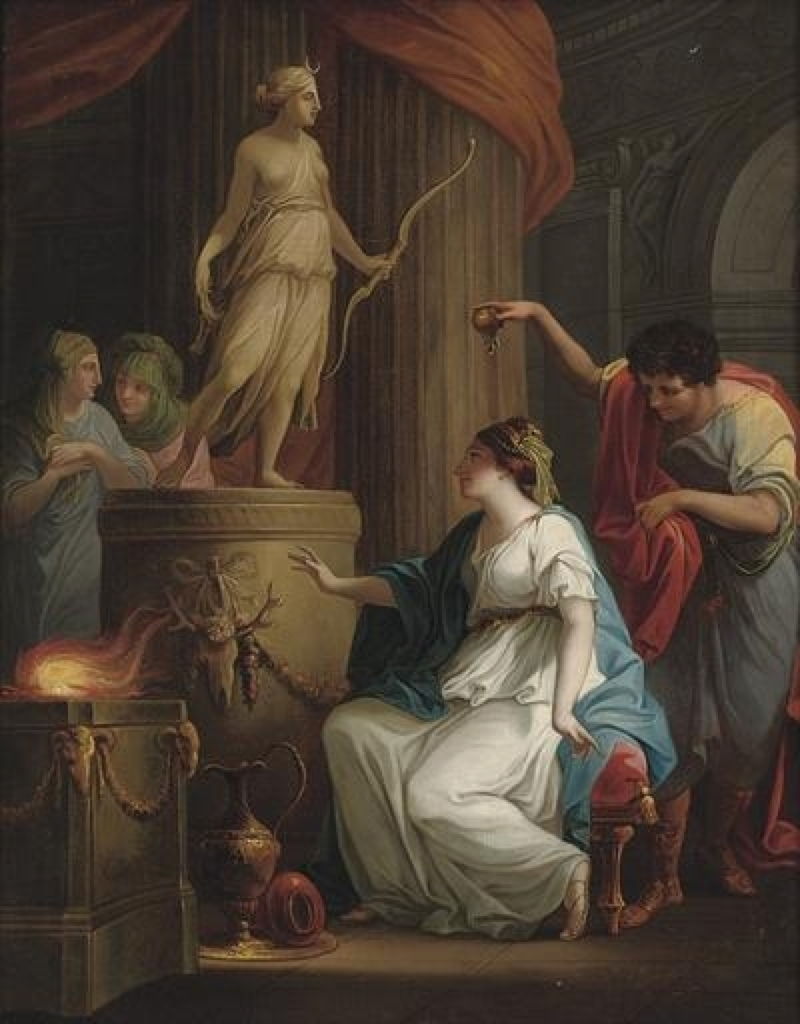Heroines 20, 21: Cydippe’s apple of love

There’s more to classical Greek and Roman myths than rape, murder and metamorphoses. Sometimes they tell touching stories of true love, like that of Acontius and Cydippe. You won’t have heard of them, because their story is tucked away in a couple of imagined letters in Ovid’s Heroines (letters 20 and 21), and in his Art of Love (1, from line 457 on).
Acontius was a young man from the lovely Greek island of Keos, who fell hopelessly in love with the beautiful young woman Cydippe. Sadly, she was of higher social standing than he was, and such a marriage was unthinkable to her family. He devised an ingenious plan to trick her into making a commitment to him: he wrote the words I swear before Diana that I will marry only Acontius on an apple.
He then approached Cydippe when she was in the temple of Diana, and rolled the inscribed apple in front of her. Her nurse picked it up, and handed it to Cydippe to read his words aloud before the altar, so binding her to the vow.
The wonderful Swiss painter Angelica Kauffman exhibited a painting titled Acontius and Cydippe at the Royal Academy in London in 1771. Like so many of her paintings, it was wildly popular, but now appears to have been lost. A copy was made by someone from her circle, and that has survived, although it was earlier thought to show Orestes and Iphigenia.
Circle of Angelica Kauffmann (1741-1807), Acontius and Cydippe Before the Altar of Diana (date not known), oil on canvas, 90.9 x 71.2 cm, Private collection. Original source unknown.
This surviving version of Acontius and Cydippe Before the Altar of Diana shows Cydippe with Acontius behind her, armed with his inscribed apple, but there’s no sign of any nurse. Acontius holds his ingeniously inscribed apple high above Cydippe, apparently waiting for the perfect moment to drop it in front of her.
Johan Fredrik Martin (1755-1816), after Angelica Kauffmann (1741-1807), Acontius and Cydippe (date not known), watercolour on print (engraving), 24.2 x 18.2 cm, Nationalmuseum (1866 from Gripsholms Castle), Stockholm. Courtesy of Nationalmuseum, Stockholm.
Kauffmann’s painting was engraved, and the Nationalmuseum in Stockholm has what I understand to be a hand-coloured print made by the Swedish painter Johan Fredrik Martin.
That’s a fine narrative work that does the story justice, but pales in comparison to the painting of Cydippe in the Rijksmuseum, by a little-known Dutch artist Paulus Bor.
Paulus Bor (c 1601–1669), Cydippe with Acontius’s Apple (date not known), oil on canvas, 151 x 113.5 cm, Rijksmuseum Amsterdam, Amsterdam. Wikimedia Commons.
His Cydippe with Acontius’s Apple is undated, but probably from around 1630-40. It puts a different slant on the story: here, Cydippe leans on the altar, alone, the inscribed apple held up in her right hand. But she isn’t reading Acontius’ words: she has clearly already said those out aloud, and now seems to be thinking through the vow she has just made.
Paulus Bor (c 1601–1669), Cydippe with Acontius’s Apple (detail) (date not known), oil on canvas, 151 x 113.5 cm, Rijksmuseum Amsterdam, Amsterdam. Wikimedia Commons.
Bor paints the details of the altar exquisitely. Cydippe’s dress may be anachronistic, but Bor brings in the skull of a sacrificed goat and festoons of flowers.
She then seemingly overlooked this inadvertent commitment that she had made in front of Diana.
Sadly, Cydippe’s family had other ideas, and found her a prospective husband of appropriate status. Shortly before the couple were due to marry, Cydippe fell ill with a severe fever, and the proceedings had to be postponed. After she had recovered, a second attempt was made to marry the couple, but again Cydippe fell ill just before the ceremonies, and so the wedding had to be called off yet again.
Unsure of what to do next, Cydippe’s parents consulted the oracle at Delphi, who told them the whole story. Recognising the strength of the vow that she had made, Cydippe and her parents finally accepted the match, and Acontius and Cydippe married with the blessing of both families.
I still feel sure that some artist would have depicted some more of their story, but my reference sources only point to poetry and operas. These include an allusion in Spenser’s Faerie Queene, verse by Edward Bulwer Lytton and the artist and designer William Morris. There have been no less than six operas written about the story, including Hoffman’s Acontius und Cydippe, first performed in 1709. Apparently Angelica Kauffmann and Paulus Bor were alone among painters.


